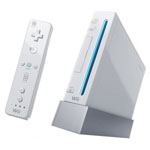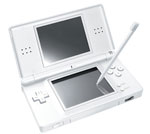
I’ve been thinking about the upcoming iPhone store, the openness of the iPhone software development, and the level playing field those two things bring. Combine that with the three video games that Apple showcased during the iPhone SDK event, and I feel that the iPhone and Apple, Inc. will have a significant impact on gaming.
First, let’s look at the current state of video games.

PC and Mac gaming
There was a time, not too long ago, that every great game could be found on the PC side of computing, and these games were selling in the millions. It was a huge industry, and the best games were PC games. Mac users, long forgotten in the video game world, were left with either buying a Windows machine just to play games on, or forgoing them altogether.
My, how things have changed.
Sure, gaming on the Macintosh is getting better. Companies like EA, Feral Interactive, Aspyr, and more are creating (and porting) many great games to the Macintosh. We also now have the luxury of running games on our Macs simply by booting them up in Windows via BootCamp or the virtualization software makers, and play them that way. It’s not ideal, but it works.
The freeware, shareware, and other small publishers are also out there creating some really terrific games for the Mac. But none of them are changing the gaming industry one whit, and in fact sales of PC games are down significantly over the last few years. (Blizzard’s World of WarCraft notwithstanding.) PC games sales are going down, and many publishers blame the rampant theft of games online. One company recently complained that while their latest title only sold a few hundred thousand copies, three times that number are somehow playing the game online. How can more people be playing a game than actually purchased it? Pirated copies.
What hasn’t changed for the PC game makers is the distribution model. PC gamers have been both buying games on the retail shelf and downloading them online for years. Nothing new there. And developing games on the PC, or Mac, is not easy or quick. And even if it were, how do you get your games in front of potential buyers?
So while the PC and Mac game development is somewhat cheap to get into, it is by no means easy. And getting people to buy your games is much harder than actually creating the game in the first place for the game developers.
Console Gaming: PlayStation 3, Wii, XBOX 360
All three offer great gaming options for both the game developer and the game buyer. At this point in time, far and away the best games to be had are on the video game consoles. They are selling record number of consoles and games. Each have some form or another of online gaming. Both the XBOX 360 and the PS3 have games that look better than almost any PC game. The Wii’s claim to fame is its innovative controllers, and it seems to have captured the casual gaming market.
With games like Halo 3 selling over 8.1 million copies in only three months, Nintendo’s Wii selling almost twenty-one million units in under two years, and the XBOX 360 game attachment rate at over seven games per console*, this generation of home video game consoles look to be the most lucrative yet.

So what is the problem with the consoles? They are closed systems, meaning it is both expensive and difficult to develop games for them. A small game manufacturer may look at the number of Wii’s in the market and think that it would be easy to make and sell a game for the system. The problem is, at least with the Wii, the only titles that do really well for the system are those created by Nintendo themselves. (Super Mario World, Zelda, Smash Brothers, etc.) Third party games don’t come close to selling as many units. And for all the hype surrounding the system, most third party games on the Wii are terrible, and the buying public is less likely to buy them. Most are still too busy playing Wii Bowling.
The online gaming world for the Wii is dismal, while the XBOX 360 has a thriving community of online play. Most games released for the Microsoft box has one form or another of online play, but to take advantage of that, XBOX 360 owners have to shell out $50 a year for XBOX Live, as well as a high-speed internet connection. Taking a page from Vista, Microsoft has also created a number of different SKU’s of the system, some with hard drives, some not. Some have HDMI ports, while others do not. Microsoft has the best library of titles at the moment in this new generation of consoles, but the console itself has been plagued by system failures and an annoyingly loud sound when the DVD drive is working.

XBOX Live is a very good system, unmatched as of yet by Sony’s PlayStation online. But there is a fee to use it, and developers looking to get their games sold there have historically gone through a very long process to get their games approved. While there have been some pretty decent online games released exclusively through XBOX Live (Pac Man Championship edition comes to mind) most are either casual titles or classic games. And again, the process to actually sell games on XBOX Live is not the most friendly system. This may change soon with the XNA initiative, but only time will tell.

The PlayStation 3 has huge potential, but at this moment is missing a key ingredient: games. There is simply very few really compelling games for the PS3, and some of the best titles are also available on the XBOX 360. Their online service is free, and is expected to get a major, and much needed, overhaul sometime this year. With each PS3 shipping standard with a Blu-Ray player built-in, and great games in the pipeline coming soon, the future of the PS3 looks very bright.
The problem is developing games for the system. Because the PS3 is a very high-end platform, and gamers are expecting better graphics and bigger play, developing for the PS3 is neither cheap nor easy. Big developers have already complained about the difficulty of programming on the system. Many credible gaming news outlets have reported that the biggest game this year, Grand Theft Auto 4, was delayed a full half-year because of problems getting the game done correctly on the PS3, while the XBOX 360 version has been both easier to develop for, and in fact was the lead SKU the game was created on.
So far, very few really original games have been released exclusively on the PS3 Online service. Those that have are either regular games that you could buy in a store (WarHawk) or retreads of older games.
Developing any game for these three consoles is a long, expensive, and risky proposition.
DS / PSP
Imagine developing a game for an inexpensive handheld computer with an installed base (as of the end of 2007) of 65 Million units. Sounds like a good idea, no? The Nintendo DS is a dual-screen heavyweight in the portable gaming world. There are a ton of games available, and some are very good. It’s popular with both boys (14 million copies of Super Mario World) and girls (18 million copies of Nintendogs.) Its touch screen has been a hit with everyone, and sales don’t look ready to slow down anytime soon.

The big problem with development on the DS is it is easy to get lost in the crowd. Quality does not always rise to the top of the sales charts. You are somewhat limited on the pure horsepower of the system. It sports a 67 MHz ARM chip, and a 33MHz ARM7TDMI and 4MB of RAM. In 2008, those are paltry numbers to say the least. The two separate screens are 3″ at 256X192 pixels. On the upside, it has built-in Wi-Fi (802.11b/g) for online gaming. Currently, you cannot buy games over the internet for the DS, just cartridges.

On the other hand, the Sony PSP is more iPhone than the DS is. It has a much more powerful processor, a 333MHz MIPS R4000, as well as built-in Wi-Fi. Sony has plans for an online store for PSP games, and has already started to release original PlayStation games for it via the PS3 online store.
There are a few good games for the PSP, but not many. It launched in December 2004, and has played second fiddle to the DS ever since. It is technically a much more powerful system, and while sales are not bad at 26 million units sold, it still has not really caught on fire as Sony had hoped.
Like many other Sony products, they decided to use a propriety and often buggy storage medium for their games, the disc-based UMD. Load times are slow, and game discs have been known to easily get damaged. Still and all, the PSP could have a very bright future.

Other Cell Phones
Wow, should we even go here? Games on Cell Phone are, almost without exception, extremely bad. Horrible. Small screen, clunky interface, and horrible graphics make playing games on a regular cell phone, well, not fun. They are also, for what you actually get, expensive and many times buggy. You can only buy games via the wireless carriers online gaming service, there are no demo of games (or very limited) and it’s impossible to know what you are actually buying until after you have done so and it’s on your phone.
Video games on cell phones are almost a joke. People buy them, I think, because it is easy to do so, and (usually) kids want something else on their phone besides the default applications. While the profits from game sales on cell phones are a windfall for the carriers, it is obvious by the lack of quality games and attention to detail that it is not worth big developers resources to make them. As for small game publishers, forget it.
iPhone / iPod Touch
And now we come to the Apple iPhone. A brand-new platform that has both huge potential in innovation, and an open development community backed by Apple. With an online store on every iPhone, as well iTunes, this puts small game developers on an equal footing with the likes of EA or Sega. Apple is giving away the NDK for iPhone development. Buyers will be able to purchase games using their iTunes account, which translates to millions of iTunes users. Apple is acting as a gatekeeper, but in their own words, they are only disallowing porn and the like on the iPhone. Apple is keeping 30% of each sale, true, but how much money do you think a game developer on the DS, PSP, XBOX 360, etc. earn per game sold? It is much less than 70%.
The iPhone represents a new way for game developers, both big and more importantly, small, to reach a vibrant, growing community of users eager and starving for their product. Apple predicts selling 10 million iPhones this year, and if the third-party software development is as popular as it looks to become, they will probably pass that prediction.
The iPhone did not start out as a gaming machine, but it is becoming one. The Sony PSP started out as a gaming machine, but is trying to become something more. Which do you think has the greatest chance for success?
Unlike the PSP, there is a huge development movement towards the iPhone, while third party software titles (non-games) on the PSP are pretty nonexistent. The big news for the PSP is Skype coming to the unit. No AIM, a crappy web browser, and a failed attempt to get PSP owners to use it as an MP3 player means the iPhone has already passed it in terms of technology and adoption. As for Skype, Apple has already said they would allow VoIP on the iPhone, so I expect to see Skype as one of the first applications ready when the iPhone 2.0 update rolls out.
What makes the iPhone so appealing is how easy it should be for users to buy content. It will be a simple touch or two. You won’t have to go out and find software for it, it will be right there on the phone, wherever you are. Buying a game up to this point, with the possible exception of the PC user, usually entails going to a store, or Amazon, and buying a physical disc. All three consoles now have online stores, but you have to be sitting on your couch in your living room to buy one. You have to use a credit card with all three services. With the iPhone, anything you buy is tied to your iTunes account, which you can set up to use PayPal. Impulse buys will account for a huge segment of iPhone game (and other software) titles. It will be almost too easy.
For the developers, they will be able to release a game on the iPhone and immediately reach millions of customers. If they sell their game for ten dollars, and one million iPhone users buy it, they will make seven million dollars. Imagine a kid pounding away on the iPhone SDK and cranking out a cool, simple game. Imagine that just this year alone, ten percent of iPhones buy his ten dollar game. Imagine his parents with a new house, college paid for, etc. Think this isn’t possible? Think again. Not only is it possible, it’s probable. Now imagine the same kid making a ten dollar shareware game for the PC, and uploading it to his personal website. How many people will find it? How many will actually buy it? Imagine the same kid trying to create a game for the PS3, the Wii, or the DS. How long before he finishes the game until his product hits the store shelves? It probably never will, but even if it does, how much money will he actually make on it?
The iPhone will change everything for buyers, developers, and everyone in between. Look for many new millionaires over the next two years.
* Attach rate is how many games an owner of a game system owns. In this case, based on NPD numbers, each XBOX 360 buyer owns at least seven games.

Leave a Reply
You must be logged in to post a comment.